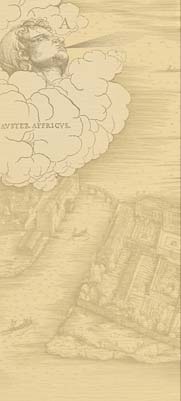Michael's Life: Nochiero 1407-1413
While serving in the Guard in 1405, Michael was temporarily promoted from proder to nochiero, likely because the previous holder of the position had died or fallen ill mid-voyage. Michael was very proud of this promotion, noting in his manuscript that it was the first honor he received. It was his first real step up the chain of command. Now he could sleep below decks and not at the rowing bench. He could eat at the officers' table, so the food was much better. Plus, he had an opportunity both to learn from and make an impression on the kind of people who could help him in the future.
Michael sailed to London as proder again in 1406, but returned to the Guard as nochiero in 1407, serving in this capacity on military and merchant galleys from 1407 to 1413.
Tasks of the nochiero
During these years, Michael was one of eight nochieri. The exact duties of the nochiero and most other ship’s officers in this time period are not known from contemporary sources. For the most part, their duties can only be surmised by extrapolating back from later documents. Such accounts must be considered reasonable hypotheses, rather than proven facts.
The nochieri were basically apprentices who probably learned everything they could about shipboard operations. Under the watchful eye of the paron and the comito, they were taught how to ballast galleys to preserve the vessels' stability and to stow the ships properly. The nochieri also managed the anchors and learned how to steer. Perhaps most significantly, they learned how to handle the large, triangular lateen sails that were used whenever possible.
Military voyages
Michael sailed as a nochiero in the Guard from 1407 to 1410, but we don't always know where he went or what he did. There was no major sea battle of the time, but pirates were a perennial problem, and Michael was sent with a fleet that captured several Aegean pirates in 1409.
Venice's main goal at this time, however, was to regain control over the eastern coast of the Adriatic, which had been lost in the previous century. The effort put Venice in a complicated four-way struggle with the Hungarians, who claimed the territory; local nobles who wanted their independence; and the Turks, who were steadily expanding their control over Greece and the Balkans.
The capture of Naupaktos in 1407 illuminates the nature of Michael's participation in the struggle. Naupaktos, known to the Venetians as Lepanto, had one of the best harbors on the northern coast of the Gulf of Corinth, the body of water that almost bisects Greece. The Venetians feared that the Turks would take control of the town, with its fine harbor, which would allow Turkish corsairs to raid Venetian bases at Corone and Modone, as well as Venetian commerce in the Adriatic.
In 1407 the Venetians sent the Guard fleet under captain of the fleet Fantin Michiel to take the town, either by force or by negotiation. When Michiel's fleet arrived, it was early in the morning, and Michiel saw an opportunity to land troops and take the city without a struggle. He placed the assault under the command of Michael's sopracomito, Bertuccio Diedo. Diedo's troops consisted of crossbowmen from the various galley crews, including nochieri like Michael, who were normally equipped with bows and expected to fight.
Lepanto was a fortified city, whose walls surrounded the harbor and then rose up a steep hill to a castle perched on top. Diedo's troops, Michael among them, quickly secured the harbor, then raced to the top of the hill in the hopes of taking the castle by surprise. Alas, things did not go as planned. Whether intentionally or by accident, the Venetians set part of the lower town on fire, then met stiff resistance from soldiers and citizens who had fled to the castle. Bertuccio Diedo was hit on the head by a heavy stone thrown from the castle walls that broke all his teeth. Many others were wounded in the hail of stones and arrows that rained down from the castle walls. The Venetians were forced to retreat.
After a parley, Lepanto was turned over to the Venetians, but the Turks captured it anyway in 1444. It would gain fame in 1571 as the site of the battle between Venetians and Turks that finally stopped the Ottoman advance.
Commercial voyages
Michael's final years as a nochiero were spent on three voyages to Flanders in 1411, 1412, and 1413. On these voyages he got better food and the right to sleep inside. In addition, his portata—the right to carry goods to trade on his own behalf—increased.
Michael also completed his apprenticeship in practical shiphandling. More important, he mastered the basics elements of galley navigation. He still couldn't set a course on his own authority, but as a nochiero he probably learned how to keep a course at the rudder, to use a compass, sea charts, and a mathematical technique for navigating known as the marteloio. The Flanders voyage probably also provided an excellent learning environment in which Michael may have been privy to the discussions of senior officers and pilots concerning the course to be sailed and the reasons for choosing it.
During his three journeys as nochiero, Michael became increasingly familiar with the Flanders route; he had already sailed there twice as an oarsman. The experience he absorbed would prove extremely valuable to him in the coming years.
< Homo da Remo | Paron >











